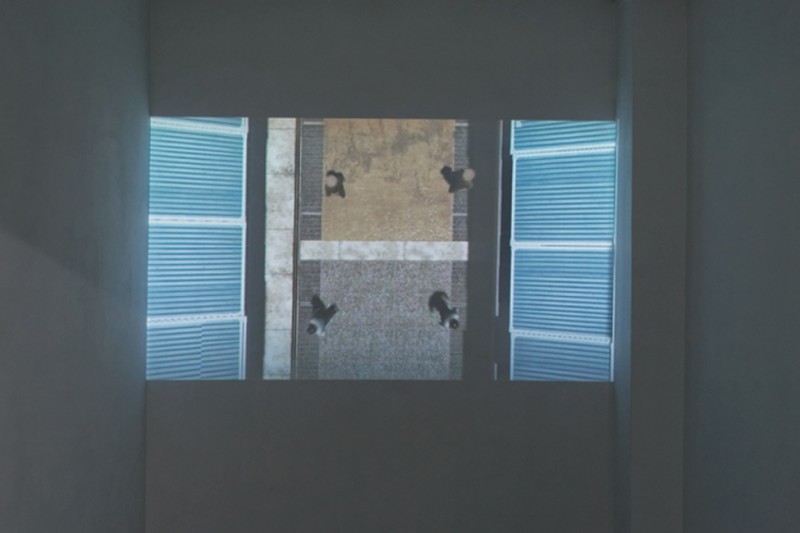
Opening Saturday, September 7 from 6pm.
The gallery will be closed from the 24.09 to 03.10.2013
Hayoun Kwon was born in Seoul (South Korea) in 1981. She first studied at the Ecole des Beaux-Arts de Nantes, and then graduated from the Fresnoy – Studio national des Arts contemporains in 2011. Her work revolves mostly around the notions of memory (wether individual or collective), boundaries and limits, questionning the blurred lines between intention and interpretation, construction and fiction, recollection and invention. She examines the ambivalent relationships between reality and fiction, theatre and real life. Eventually, “La ligne fictive” – “The fictitious line”, an exhibition ensuing from the research program L’invention du Nord that Hayoun Kwon carries out with Christiane Cavallin Carlut at the Ecole Supérieure des Beaux-Arts de Nantes – presents itself as a line of research on the fiction mechanisms. That is why the artist explores several trails.
In the set of works titled The village (2013, video and installation) Hayoun Kwon brings face to face the reality of a border – the Korean Demilitarized Zone (DMZ), a strip of land that is 248 km (160 mi) long, approximately 4 km (2.5 mi) wide and serves as a buffer zone between North and South Korea – and its mise-en-scène. In the video The village (2013) Hayoun Kwon deconstructs the artifact of a north korean propaganda village that plays a role as a luxury showcase. Built in the 1950’s, the village was located so that it would be visible from the South. But a close observation of the buildings reveals that they are empty, as they would be for a stage set. The model The village (2013) is freely inspired by this same village, Kijong-dong. With this piece of work, Hayoun Kwon points out the spectral and partial aspect of this place: it is a scenery, a made-up place that can only be reached within our imagination.
By showing us the model manufacturing process in a serie of three photographs (Mode d’emplois, 2013) Hayoun Kwon blurs even more the borders between reality and fiction. Our vision of the assembly is even more clouded as the shadow of the model house shown is superimposed on the model itself, as if it could only exist as and for its own image…
Panmunjom (2013) goes further in the questioning on the fictional dimension of the DMZ (and of demarcations in general) by reducing to colour spots soldiers facing each other from both sides of the border… Who is who? Who is where? Where are we? As the shooting authorizations where cancelled following the 2013 North-Korean crisis, the video simulates the filming with a thermal imaging camera reproducing images at 37°C (98.6°F) – in other words, our body temperature. Hence, the abstraction achieved through scientific imaging (re)places on an equal stage the soldiers no matter what side they are on, and thus cancels the very notion of border.
The human being is also central in Expression (2013) a video made of archive images shot after Kim Jong Il death. Hayoun Kwon slows the images down, dissects the feelings, up to the point where they are hardly interpretable… Is it joy? Is it sadness? Is it staged? The research program L’Invention du Nord carried out at the École Supérieure des Beaux Arts de Nantes also deals with these questions.
The video Lack of evidences (2011) is at once a tale, an investigation and the autopsy of a cultural dilemna. Through the story of a Nigerian exiled in France, Hayoun Kwon broaches the subject of memory reconstitution and wonders about the fictional aspect of testimony. She investigates the relationships between historical truth and narrative truth, real facts and reported speeches.
“La ligne fictive” is a thought process along which we are invited to wonder on how reality and fiction tangle. On the space inbetween the tangibility of a border or a dividing line and its actual reality.
…………………………………………………………………….

The Village, 2013, video HD, color, stereo, 19/6, 6’28″, edition of 3 + 2 AP, photo © Aurélien Mole

The Village, 2013, video HD, color, stereo, 19/6, 6’28″, edition of 3 + 2 AP, photo © Aurélien Mole

Exhibition view, La Ligne Fictive, Hayoun Kwon, Dohyang Lee gallery, photo © Aurélien Mole

The Village, 2013, video HD, color, stereo, 19/6, 6’28″, edition of 3 + 2 AP, photo © Aurélien Mole

Pan Mun Jom, 2013, animated film, color, silent, 19/6, 4’00″, edition of 3 + 2 AP, photo © Aurélien Mole

Pan Mun Jom, 2013, animated film, color, silent, 19/6, 4’00″, edition of 3 + 2 AP, photo © Aurélien Mole

Mode d’emplois, 2013, serie of 3 photographs laminated on Dibond, 59,8 x 49,4 cm each, unique pieces, photo © Aurélien Mole

Exhibition view, La Ligne Fictive, Hayoun Kwon, Dohyang Lee gallery, photo © Aurélien Mole

Expression, 2013, video, archive images, color, silent, 3/4, 10’30″, edition of 3 + 2 AP, photo © Aurélien Mole

Exhibition view, La Ligne Fictive, Hayoun Kwon, Dohyang Lee gallery, photo © Aurélien Mole

The Village, 2013, model made of wood and plastic, 230 x 120 x 20 cm, unique piece, photo © Aurélien Mole

Exhibition view, La Ligne Fictive, Hayoun Kwon, Dohyang Lee gallery, photo © Aurélien Mole

Lack of Evidence, documentary animation film, 2011, 9′ 20″, video, color, HD, Dolby Surround prologic 1, France, production Le Fresnoy, edition of 5, photo © Aurélien Mole

Lack of Evidence, documentary animation film, 2011, 9′ 20″, video, color, HD, Dolby Surround prologic 1, France, production Le Fresnoy, edition of 5, photo © Aurélien Mole
